Gigantoraptor erlianensis Xu et al., 2007
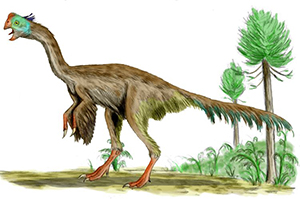
(Da: en.wikipedia.org)
Phylum: Chordata Haeckel, 1874
Subphylum: Vertebrata Cuvier, 1812
Classe: Dinosauria Owen, 1841
Ordine: Saurischia Seeley, 1887
Famiglia: Caenagnathidae Sternberg, 1940
Genere: Gigantoraptor Xu et al., 2007
Descrizione
Benché recenti studi dicano che questo dinosauro sia un "primitivo" genere della sua famiglia, è certamente il più grosso di tutti: 8 metri per una tonnellata e mezzo. Superava senza difficoltà le stazze del Citipati e del Caudipteryx, altro abitante della sua zona. Benché le sue dimensioni fossero veramente uniche, era, come altri dinosauri, più un uccello che un rettile primitivo. Aveva infatti un poderoso becco, anche se fino ad oggi non è stata trovata traccia delle sue probabili penne.
Diffusione
Genere estinto di dinosauro teropode oviraptorosauride vissuto nel Cretaceo superiore, circa 85 milioni di anni fa (Santoniano), in quella che oggi è la Mongolia. Il genere è monotipico.
Bibliografia
-X. Xing, Q. Tan, J. Wang, X. Zhao e L. Tan, A gigantic bird-like dinosaur from the Late Cretaceous of China, in Nature, vol. 447, n. 7146, 2007, pp. 844-847.
-Pickrell, N. (2014). Flying Dinosaurs: How fearsome reptiles became birds. NewSouth Publishing. 256 pp.
-W. Ma, J. Wang, M. Pittman, Q. Tan, L. Tan., B. Guo e X. Xu, Functional anatomy of a giant toothless mandible from a bird-like dinosaur: Gigantoraptor and the evolution of the oviraptorosaurian jaw, in Scientific Reports, vol. 7, n. 1, 2017, pp. 16247.
-T. Tsuihiji, M. Watabe, R. Barsbold e K. Tsogtbaatar, A gigantic caenagnathid oviraptorosaurian (Dinosauria: Theropoda) from the Upper Cretaceous of the Gobi Desert, Mongolia, in Cretaceous Research, vol. 56, 2015, pp. 60-65.
-R. Molina-Pérez e A. Larramendi, Dinosaur Facts and Figures: The Theropods and Other Dinosauriformes, Princeton, Princeton University Press, 2019, pp. 54.
-Gregory S. Paul, Theropods, in The Princeton Field Guide to Dinosaurs, Princeton: Princeton University Press, 2010, pp. 152.
-N. E. Campione, D. C. Evans, C. M. Brown e M. T. Carrano, Body mass estimation in non-avian bipeds using a theoretical conversion to quadruped stylopodial proportions, in Methods in Ecology and Evolution, vol. 5, n. 9, 2014, pp. 913-923.
-R. B. J. Benson, N. E. Campione, M. T. Carrano, P. D. Mannion, C. Sullivan, P. Upchurch e D. C. Evans, Rates of Dinosaur Body Mass Evolution Indicate 170 Million Years of Sustained Ecological Innovation on the Avian Stem Lineage, in PLOS Biology, vol. 12, n. 6, 2014, pp. e1001896.
-W. S. Persons e bruh, Oviraptorosaur tail forms and functions, in Acta Palaeontologica Polonica, 2014.
-J. Lü, P. J. Currie, L. Xu, X. Zhang, H. Pu e S. Jia, Chicken-sized oviraptorid dinosaurs from central China and their ontogenetic implications, in Naturwissenschaften, vol. 100, n. 2, 2013, pp. 165-175.
-N. R. Longrich, P. J. Currie e D. Zhi-Ming, A new oviraptorid (Dinosauria: Theropoda) from the Upper Cretaceous of Bayan Mandahu, Inner Mongolia, in Palaeontology, vol. 53, n. 5, 2010, pp. 945-960.
-M. C. Lamanna, H. D. Sues, E. R. Schachner e T. R. Lyson, A New Large-Bodied Oviraptorosaurian Theropod Dinosaur from the Latest Cretaceous of Western North America, in PLOS ONE, vol. 10, n. 4, 2014, pp. e0125843.
-G. Funston e P. J. Currie, A new caenagnathid (Dinosauria: Oviraptorosauria) from the Horseshoe Canyon Formation of Alberta, Canada, and a reevaluation of the relationships of Caenagnathidae, in Journal of Vertebrate Paleontology, vol. 36, n. 4, 2016, pp. e1160910.
-D. J. Simon, Giant Dinosaur (Theropod) eggs of the Oogenus Macroelongatoolithus (Elongaroolithidae) from Southeastern Idaho: Taxonimic, Paleobiogeographic, and Reproductive implications, 2014.
-H. Pu, D. K. Zelenitsky, J. Lü, P. J. Currie, K. Carpenter, L. Xu, E. B. Koppelhus, S. Jia, L. Xiao, H. Chuang, T. Li, M. Kundrát e C. Shen, Perinate and eggs of a giant caenagnathid dinosaur from the Late Cretaceous of central China, in Nature Communications, vol. 8, n. 14952, 2017, pp. 14952.
-K. Tanaka, D. K. Zelenitsky, J. Lü, C. L. DeBuhr, L. Yi, S. Jia, F. Ding, M. Xia, D. Liu, C. Shen e R. Chen, Incubation behaviours of oviraptorosaur dinosaurs in relation to body size, in Biology Letters, vol. 14, n. 5, 2018, pp. 20180135.
-Z. X. Guo, Y. P. Shi, Y. T. Yang, S. Q. Jiang, L. B. Li e Z. G. Zhao, Inversion of the Erlian Basin (NE China) in the early Late Cretaceous: Implications for the collision of the Okhotomorsk Block with East Asia (PDF), in Journal of Asian Earth Sciences, vol. 154, 2018, pp. 49-66.
-J. Van Itterbeeck, D. J. Horne, P. Bultynck e N. Vandenberghe, Stratigraphy and palaeoenvironment of the dinosaur-bearing Upper Cretaceous Iren Dabasu Formation, Inner Mongolia, People's Republic of China, in Cretaceous Research, vol. 26, n. 4, 2005, pp. 699-725.
-P. J. Currie e D. A. Eberth, Palaeontology, sedimentology and palaeoecology of the Iren Dabasu Formation (Upper Cretaceous), Inner Mongolia, People's Republic of China, in Cretaceous Research, vol. 14, n. 2, 1993, pp. 127-144.
-(ZH) H. Xing, Y. He, L. Li e D. Xi, A review on the study of the stratigraphy, sedimentology, and paleontology of the Iren Dabasu Formation, Inner Mongolia, in D. Wei (a cura di), Proceedings of the Thirteenth Annual Meeting of the Chinese Society of Vertebrate Paleontology, Beijing, China Ocean Press, 2012, pp. 1-44.
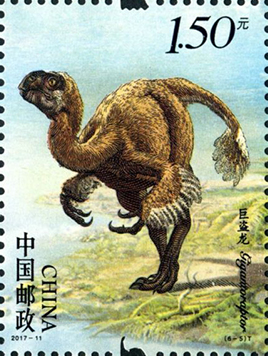
|
Data: 19/05/2017
Emissione: Dinosauri cinesi Stato: China (P.R.C.) |
|---|
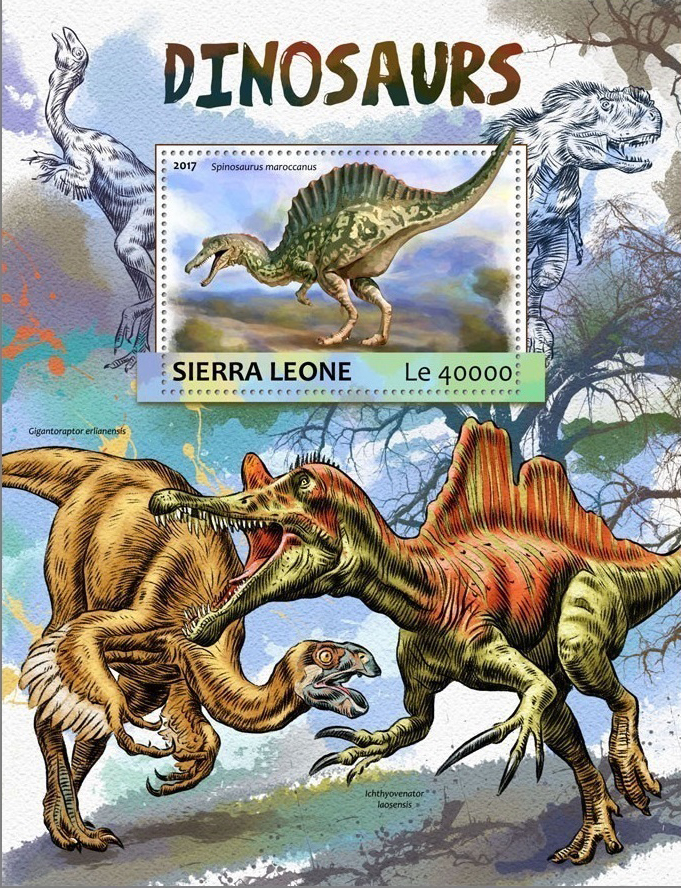
|
Data: 30/03/2017
Emissione: Dinosauri Stato: Sierra Leone |
|---|
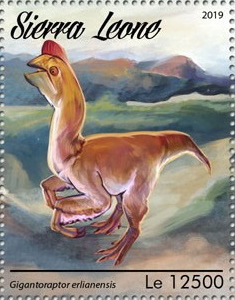
|
Data: 28/03/2019
Emissione: Dinosauri Stato: Sierra Leone Nota: Emesso in un foglietto di 4 v. diversi |
|---|
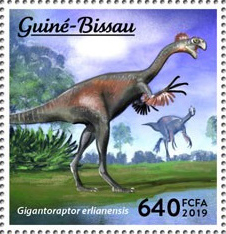
|
Data: 17/07/2019
Emissione: Dinosauri Stato: Guinea-Bissau Nota: Emesso in un foglietto di 5 v. diversi e uma vignetta senza valore |
|---|